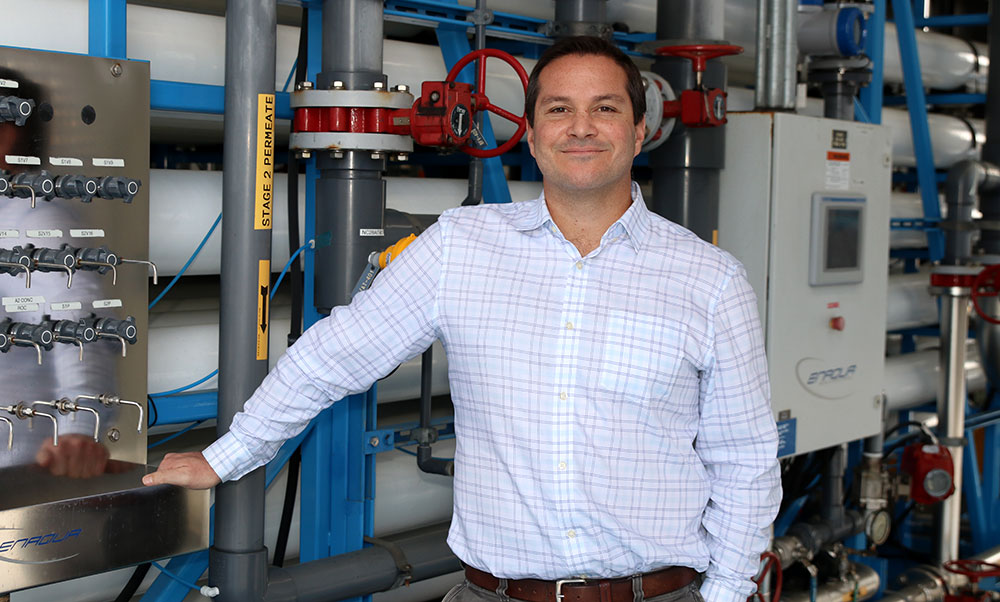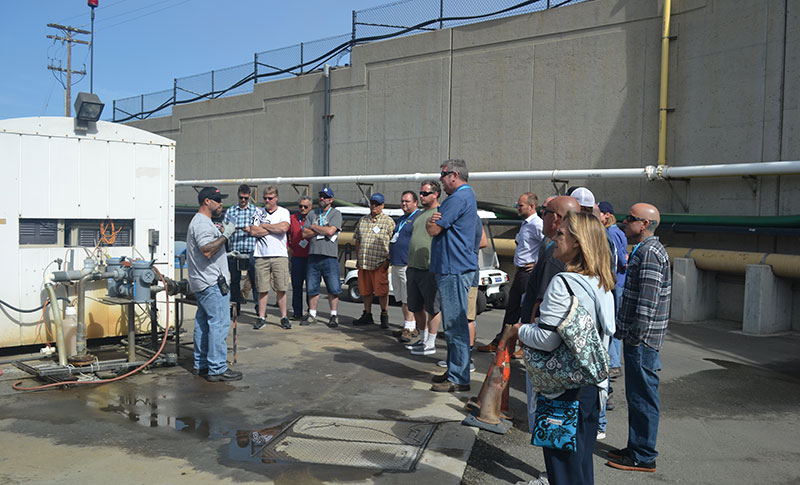
Juan Guerreiro is a Deputy Director for the City of San Diego Public Utilities Department. He’s also the Chief Plant Operator for the City’s large wastewater treatment facilities.
About this series: Each month CWEA is interviewing an innovative thinker in the water profession. We’re asking each person “The future of the water profession is …”
Juan Guerreiro
Deputy Director
City of San Diego, Public Utilities Department
Grade V Wastewater Treatment Operator, SWRCB
Dual-Associate Degrees, Water and Wastewater, Cuyamaca College
Bachelors Degree, San Diego State University
Masters Degree, Water Science, Policy and Management, University of Oxford
Juan Guerreiro grew up in San Diego, attending high school there. “I went off to Long Beach State, playing water polo, but that didn’t work out, so I eventually ended up in the Virgin Islands working as a cabana boy.”
It was in the Virgin Islands Juan had his first insight into the importance of a reliable water source.
“There’s no community water supply in the Virgin Islands. Water was collected in cisterns on roof tops, and it was my first experience with not being able to drink tap water. We had to buy expensive bottled water to drink.”
One day, in the middle of a shower, the cistern ran dry, and Juan was left with a head covered in shampoo. He had to use the expensive bottled water to rinse it off.
It was then he realized, “Wow! Water does stop if you don’t manage it properly.”
Eventually Juan returned to San Diego and started his career as an Operator-in-Training with Dudek. Scott Pastore, a friend from high school, was Juan’s supervisor, and his father John Pastore, an engineer with Dudek, was a mentor to Juan. Together Scott and John convinced Juan the water profession offered a strong career path, encouraging him to broaden his experience and continue his education and certification.
Over his 13 year career in water, Juan specialized in wastewater treatment and worked for several agencies, including: City of Oceanside; Otay Water District; Rural Community Assistance Corporation; Veolia; and now the City of San Diego. Juan is the Chief Plant Operator and in charge of the Point Loma Wastewater Treatment Plant and three satellite facilities.
1) What do you believe is the future of the water profession?
I believe the future of the water profession will see further acceptance of the one-water concept with less delineation between water and wastewater professions.
The continued expansion of advanced water treatment facilities will naturally continue to facilitate this union. We see it now in the cooperating and merging of research foundations, industry associations, and public utilities. Although professionals will have their areas of expertise, whether it be wastewater treatment or drinking water treatment, there will be more opportunity to cross train and transition and advanced water treatment certification will likely provide one avenue for professionals to cross over.
2) What can you tell me about the Pure Water Project?
The Pure Water Project is a clear example of the movement described above, where wastewater has become an asset as opposed to a liability.
We at the City of San Diego have embarked on a massive potable reuse project to divert an additional 32 million gallons per day from the Point Loma Wastewater Treatment Plant to the North City Water Reclamation Plant (NCWRP) via additional pumping from current pump stations and through the addition of the peak capacity 37 MGD Morena Pump Station.
The NCWRP will be expanded from its current 30 MGD capacity to 52 MGD. This facility will also be converted from the Modified Ludzack Eddinger (MLE) treatment process to a 4-stage Bardenpho process to achieve additional nutrient removal. The NCWRP will provide enough tertiary effluent to supply reclaimed water for the current recycled water distribution system, and enough feed water to the new North City Pure Water Facility that’s being designed to produce 30 MGD of purified water.
The purified water will be pumped to the Miramar Reservoir and will be utilized as supply water for the Miramar Water Treatment Plant to produce a sustainable drinking water supply for the San Diego region.
On an Adjusted Average Daily Flow basis in 2022, the diversion would be 52 million gallons per day (required AADF influent to NCWRP to produce 30 mgd Pure Water and 11.8 mgd of NPR) minus 26 mgd (projected dry weather flow (AADF nearly equivalent) from PS64 and PQPS in 2022) = 26 mgd additional diversion; the 32 mgd average is expected during dry weather periods when more flows are needed to augment flows received from PQPS and PS64 and also fill the equalization basins at low flow periods.

A CWEA tour of the Point Loma wastewater treatment facility in San Diego where Juan is the Chief Plant Operator.
3) What special challenges are associated with recruiting water professionals for dealing with Advanced Water Treatment (AWT)?
One challenge the water sector faces is finding highly qualified and experienced candidates to replace the current wave of highly experienced professionals who are retiring.
I think the special challenge of recruiting water professionals for AWT facilities is that it’s a developing part of the industry so the labor pool will likely be even smaller. There are a growing number of professionals with expertise and experience in this space, but nonetheless, there is likely to be more demand for the AWT skill set than supply.
This will be especially true with regard to the operations and maintenance needs of new facilities as additional permanent full-time employees will be needed.
I’ve recently joined a committee formed by CWEA and CA-NV AWWA, working towards creating a specific AWT operator certification. We’re still working on ironing out the details of what this AWT certification will mean, and tackling the challenges that face the industry as AWT becomes more prevalent.
It’s exciting to be part of the process that will define certification requirements in the future, but also a lot of work.
4) What are the benefits of membership in an association such as CWEA?
CWEA and similar associations help water professionals stay in touch with the rest of the water community. Taking part in the regional events, reading publications, attending conferences, and obtaining training and certification, really helps agencies and employees stay in touch.
5) What advice would you emphasize to anyone interested in succeeding in this field?
I would advise anyone who is interested in succeeding in this field to be inquisitive and helpful. Ask how things work and how they can possibly work better, and challenge yourself to find answers to problems.
Stay on a path towards continuous learning whether it be through formal education, certification, work experience at various agencies, reading industry material, or by asking your mentors and peers.
This all empowers you to help your water community, and helping is succeeding.
To take a tour of the Pure Water San Diego demonstration facility visit this website.
To explore water career pathways visit CAWaterJobs.org